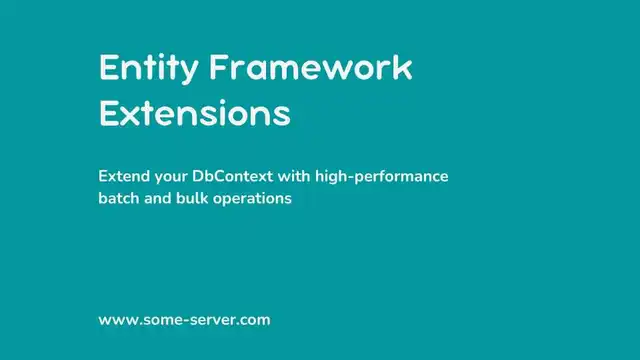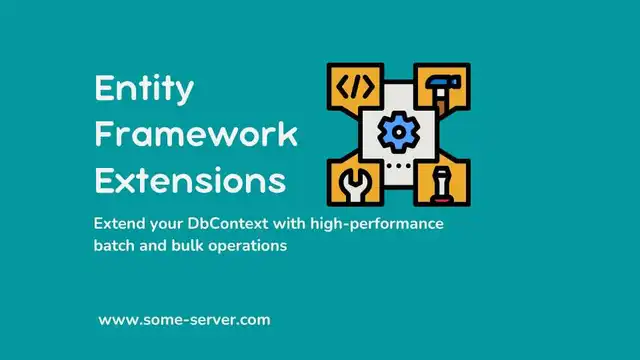Entity Framework Extensions are a powerful tool that can help you build more efficient and effective applications. In this blog post, we will discuss all you need to know about entity framework extensions, from what they are to the benefits of using them. We also include a tutorial on how to create an EF extension yourself!
What are entity framework extensions?
Entity framework extensions are a way to add functionality to your entity Framework project. This can be done in two ways: by writing code extending the EF runtime or using an extensive library.
Extension libraries let you write less code and extend the EF runtime more easily, as they take care of all the low-level plumbing for you. Extension libraries provide greater extensibility but come with a learning curve; if you’re unfamiliar with .NET programming, installing and using an extension library may be difficult.
The second way to use entity framework extensions is by writing code that extends the EF runtime. This is generally easier than extending an extension library because it doesn’t require additional installation steps, and there are fewer dependencies on other parts of Entity Framework (although this also means that your code will be less comprehensive).
In addition, if you need to change how certain features work or want full control over how your data gets rendered, this is probably where you should start.
It can be used for data access, migration, error handling, validation, security, and authorization. They offer great flexibility in tackling tasks without resorting to complex configurations or script files.
What are the benefits of using entity framework extensions?

Entity framework extensions (EFx) are code snippets that you add to your entity model to improve the performance of your database, add new features to your business operations, improve the organization of your data, and increase the reliability of your data.
Adding an EFX can be as simple as copying and pasting a few lines of code into a project or as complex as developing a fully-fledged extension from scratch. Regardless of how it’s created, all EF share four key benefits:
- They make it easier for you to understand and use the functionality provided by Entity Framework Core.
- They help you write more efficient queries by providing object-oriented implementations for common database tasks such as processing foreign key lookup or aggregate functions.
- They reduce development time by streamlining common application administration tasks.
- They increase performance by implementing best practices in storage design and management
How to create an entity framework extension?
Entity framework extensions are .NET code packs that you can use to extend the functionality of your entity models. They provide a convenient way to add custom logic and business rules without writing new classes or modifying existing ones.
There are three ways to create an entity framework extension: by using the Visual Studio templates, creating your template, or downloading one from the Microsoft Web site.
The most common scenario is when you need to implement a custom business rule in your database or model. If you’re unfamiliar with Entity Framework, it’s worth reading our overview before continuing because understanding how entities work will make working with extensions much easier.
Entity framework extensions provide a framework-level interface that allows you to customize your entity models’ defined behaviors and capabilities without custom coding them from scratch.
To access this interface, you need to create a database using Entity Framework Extensions or create a media type using Entity Framework Extensions, or modeling event ed with the EF Extension method must be functionalized through a contextual invoke of the EF Extension class rather than to construing new types upper-class for more generic behavior.
Read Also: Azure Service Endpoint: What You Need to Know (7 Best Steps)
What is the difference between Include and ThenInclude?
Entity Framework Extensions are a type of code block that allows developers to include repeatable blocks of code throughout their application. They Include extension is used for this purpose. In contrast, the Then Include extension can turn standard methods into entity constructors (this reduces the number of SQL statements sent to the database), intercept query results before they are returned to the calling code, and more.
The main difference between Include and ThenIninclude is that Include includes files within your project; then Include turns these included files into entity constructors. This allows you to reduce repetitive boilerplate code across your applications by converting common method calls into constructor invocations.
Additionally, Include enables you to handle query service results before they are returned to the calling code, except for the missing return value questions commonly asked in headers and methods in the database programming model.
How do I enable eager loading in Entity Framework Core?
Entity Framework Core enables the eager loading of entities by default. This means that the EF runtime will load any related objects (including automatically generated dependencies) as soon as they are required rather than waiting until the entire entity is loaded before doing so. This can significantly reduce the time it takes to execute a query against an existing database.
Entity framework extensions provide you with additional functionality beyond what’s available in the base Entity Framework product. To take advantage of these features, you must create a new entity framework extension and register it with your project. Once registered, you can use its APIs directly from within your codebase.
In addition to enabling eager loading, there are a few other benefits of using entity framework extensions:
- -Extending EF allows for more fine-grained control over how data is stored and accessed in your application.
- -By incorporating custom logic into your models, you can inject custom behavior into the core components of Entity Framework without having to duplicate or override them elsewhere in your code-base.
- -Entity model validation is enhanced when used in conjunction with entity framework extensions because validation rules are now applied both at compile time (when compiling an assembly that contains an entity model) and at run time (when querying or invoking methods on those models).
How does it include work in EF core?
Include works differently in EF core than in most other development frameworks. In EF, the Include template is located in the project where you want to include the dependencies.
The Include template accepts a single argument: the assembly name containing the dependencies. For example, if you wanted to include Microsoft Visual C# 6 Assemblies in your project, you would use an Include statement like this:
Include “Microsoft.Visual CSharp”
When you create an instance of an entity or connection class using Entity Framework Core’s Modeling API (or by calling one from another .NET framework library), EF looks for any assemblies that contain types corresponding to those entities and connections and includes them automatically as part of your application’s dependency tree. This allows you to benefit from all of EF Core’s features without needing to install additional assemblies on your machine.
Tips using Entity Framework Extensions
Entity Framework Extensions are an important part of any modern development project. They help you improve database design, performance, and usability through custom code. This article will provide five tips for getting started using entity framework extensions.
- Use entity framework extensions to improve database design. EF extensions let you create mappings between your databases and objects more efficiently than traditional coding methods. This can speed up your application processes by reducing the time it takes to find the information you need in your data stores.
- Use EF extensions to optimize performance. Creating optimized queries for your data stores can reduce load times on your applications and ensure that all data is quickly available when users need it.
- Use EF extensions to simplify user interfaces. Incorporating EF extensions into your application UI makes it easier for users to access and use the information they require quickly and successfully.
- Extend entities with attributes rather than setting them directly in code. Using attributes allows you to control the data associated with an entity without using code or altering this structure directly in the runtime.
- Start small and experiment – adding one or two EF extensions to constructors into your project will give you an example of how they can be used effectively in the context of your site.
Conclusion
Entity framework extensions are a great way to extend the functionality of your database, and in this blog, we discussed some of the most important aspects. By using entity framework extensions, you can add new features, alter how your data is stored, and more. If you’re interested in developing entity framework extensions, then be sure to read through these sections!




Add Comment